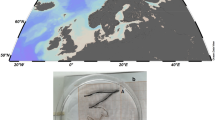Abstract
Overwintering population of Cercopagis is represented by resting eggs which hatch generally in May. Although representatives of the first parthenogenetic generation (the spring form individuals) differ morphologically from individuals of the subsequent generations (the summer form individuals) and could be keyed to a separate species – Cercopagis (Apagis) ossiani – our analysis confirm that there is only one Cercopagis species in the Gulf of Riga: Cercopagis pengoi. Notable seasonal dynamics was observed for the gamogenetic mode of reproduction, being strongly associated with the total population density. Gamogenetic females develop since the end of June and reach the maximum absolute abundance in July whereas their proportion is generally the highest in fall. The gamogenetic absolute fecundity drops to the lowest level late July but increased afterwards until the late August. One resting egg was, an average, found in 45.4%, two in 53.4% and three in 1.2% of females. Parthenogenetic fecundity was significantly higher in May–June compared to other months studied. Brood pouch of parthenogenetic females was found to contain 11.6 ± 1.0 and 10.2 ± 0.3 embryos in the spring and summer form individuals, respectively. Variation in the two modes of reproduction and fecundity is probably solely not controlled by temperature, but also by food availability and population density.
Similar content being viewed by others
References
A. Antsulevich P. Välipakka (2000) ArticleTitleCercopagis pengoi – new important food object of the Baltic herring in the Gulf of Finland International Review of Hydrobiology 85 609–619 Occurrence Handle10.1002/1522-2632(200011)85:5/6<609::AID-IROH609>3.3.CO;2-J
H. P. Benoit O. E. Johansson D. M. Warner W. G. Sprules L. G. Rudstam (2002) ArticleTitleAssessing the impact of a recent predatory invader: The population dynamics, vertical distribution, and potential prey of Cercopagis pengoi in Lake Ontario Limnology and Oceanography 47 626–635 Occurrence Handle10.4319/lo.2002.47.3.0626
M. E. A. Cristescu P. D. N. Hebert J. D. S. Witt H. J. MacIsaac I. A. Grigorovich (2001) ArticleTitleAn invasion history for Cercopagis pengoi based on mitochondrial gene sequences Limnology and Oceanography 46 224–229 Occurrence Handle10.4319/lo.2001.46.2.0224
E. Gorokhova N. Aladin H. J. Dumont (2000) ArticleTitleFurther expansion of the genus Cercopagis (Crustacea, Branchiopoda, Onychopoda) in the Baltic Sea, with notes on the taxa present and their ecology Hydrobiologia 429 207–218 Occurrence Handle10.1023/A:1004004504571
I. A. Grigorovich H. J. MacIsaac I. K. Rivier N. V. Aladin V. E. Panov (2000) ArticleTitleComparative biology of the predatory cladoceran Cercopagis pengoi from Lake Ontario, Baltic Sea and Caspian Sea Archiv für Hydrobiology 149 23–50
P. I. Krylov V. E. Panov (1998) ArticleTitleResting eggs in the life cycle of Cercopagis pengoi, a recent invader of the Baltic Sea Archiv für Hydrobiology Special Issues Advanced Limnology 52 383–392
C. L. Laxson K. N. McPhedran J. C. Makarewicz I. V. Telesh H. J. MacIsaac (2003) ArticleTitleEffects of the non-indigenous cladoceran Cercopagis pengoi on the lower food web of Lake Ontario Freshwater Biology 48 2094–2106 Occurrence Handle10.1046/j.1365-2427.2003.01154.x Occurrence Handle1:CAS:528:DC%2BD2cXmt1eqsg%3D%3D
L. F. Litvinchuk (2002) Systematics and distribution of cladocerans of the family Cercopagidae (Crustacea, Cladocera) in the northwestern part of Russia ZIN RAS St. Petersburg
J. C. Makarewicz I. A. Grigorovich E. Mills E. Damaske M. E. Cristescu W. Pearsall M. J. LaVoie R. Keats L. Rudstam P. Hebert H. Halbritter T. Kelly C. Matkovich H. J. MacIsaac (2001) ArticleTitleDistribution, Fecundity, and Genetics of Cercopagis pengoi (Ostroumov) (Crustacea, Cladocera) in Lake Ontario Journal of Great Lakes Research 27 19–32 Occurrence Handle10.1016/S0380-1330(01)70620-X
A. V. Makrushin (1978) ArticleTitleCyclicity of Cladocera (Crustacea) reproduction and environment Gidrobiologichesky Zhurnal 14 3–8
J. W. Martin C. E. Cash-Clark (1995) ArticleTitleThe external morphology of the onychopod ‘cladoceran’ genus Bythotrephes (Crustacea, Branchiopoda, Onychopoda, Cercopagididae), with notes on the morphology and phylogeny of the order Onychopoda Zoologica Scripta 24 61–90
Mordukhai-Boltovskoi, F. D. & I. K. Rivier, 1987. Predatory cladocerans Podonidae, Polyphemidae, Cercopagidae and Leptodoridae in the world fauna. Nauka, Leningrad (in Russian)
Naumenko, E. N. & Yu. Yu. Polunina, 2000. New cladocera species – Cercopagis pengoi (Ostroumov, 1891) (Crustacea) in the Vistula Lagoon on the Baltic Sea. ICES C.M. 2000/U:14
H. Ojaveer M. Simm A. Lankov (2004) ArticleTitlePopulation dynamics and ecological impact of the non-indigenous Cercopagis pengoi in the Gulf of Riga (Baltic Sea) Hydrobiologia 522 261–269 Occurrence Handle10.1023/B:HYDR.0000029927.91756.41
Ojaveer, H., M. Simm, A. Lankov, & A. Lumberg, 2000. Consequences of invasion of a predatory cladoceran. ICES C.M. 2000/U:16
I. K. Rivier (1998) The predatory Cladocera (Onychopoda: Podonidae, Polyphemidae, Cercopagidae) and Leptodorida of the World Backhuys Leiden
Rivier, I. 2000. On the species diversity of subgenus Cercopagis (Cercopagidae, Polyphemoidea) in the Baltic Sea. Abstracts of Aquatic Sciences Meeting Research Across Boundaries. June 5–9, Copenhagen, Denmark. American Society of Limnology and Oceanography (ASLO), 2000, SS21- p. 6
M. Simm H. Ojaveer (1999) ArticleTitleOccurrence of different morphological forms of Cercopagis in the Baltic Sea Proceedings of Estonian Academy of Sciences. Biology Ecology 48 169–172
S Strake (2002) ArticleTitleThe contribution of non-indigenous Cercopagis pengoi in the mesozooplankton community and its population analysis in the Gulf of Riga Proceedings of Estonian Academy of Sciences. Biology Ecology 51 91–102
Telesh, I. V., L. F. Litvinchuk, P. V. Bolshagin, P. I. Krylov & V. E. Panov, 2000. The peculiarities of biology of the Ponto-Caspian species Cercopagis pengoi (Crustacea: Onychopoda) in the Baltic Sea. In Species Introsucers in the European Seas in Russia, p. 130–150. Apatity print, Kola Science Centre RAS, Apatity (in Russian)
A. Uitto E. Gorokhova P. Välipakka (1999) ArticleTitleDistribution of the non-indigenous Cercopagis pengoi in the coastal waters of the eastern Gulf of Finland ICES Journal of Marine Science 56 IssueIDSupplement 49–57
P. M. Yurista (1992) ArticleTitleEmbryonic and postembryonic development in Bythotrephes cederstroemi Canadian Journal of Fisheries and Aquatic Sciences 49 1118–1125 Occurrence Handle10.1139/f92-124
Author information
Authors and Affiliations
Corresponding author
Rights and permissions
About this article
Cite this article
Simm, M., Ojaveer, H. Taxonomic Status and Reproduction Dynamics of the Non-Indigenous Cercopagis in the Gulf of Riga (Baltic Sea). Hydrobiologia 554, 147–154 (2006). https://doi.org/10.1007/s10750-005-1015-6
Issue Date:
DOI: https://doi.org/10.1007/s10750-005-1015-6




